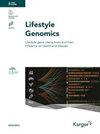血浆类胡萝卜素浓度与脂质图谱之间联系的多密克戎数据的综合网络分析
IF 1.4
4区 医学
Q3 GENETICS & HEREDITY
引用次数: 5
摘要
引言:类胡萝卜素是水果和蔬菜消费的可靠生物标志物,与脂质状况呈正相关。循环类胡萝卜素浓度可能与几种组学特征相互作用,包括基因组、转录组和表观基因组。很少有研究使用多组学方法,也很少包括饮食等环境因素。目的:本观察性研究的目的是使用加权基因相关网络分析(WGCNA)来检验以总类胡萝卜素为代表的多组学数据在饮食和脂质图谱之间的相互联系中的潜在作用。方法:在48名健康受试者中,使用回归法检测472245个CpG位点的血液白细胞DNA甲基化水平和18160个转录物的全血基因表达水平与总类胡萝卜素浓度的相关性。WGCNA用于鉴定与脂质图谱相关的共组学模块和枢纽基因。结果:在与总类胡萝卜素浓度相关的基因中,共有236个基因在DNA甲基化和基因表达水平上被鉴定。使用WGCNA,鉴定了六个模块,由以颜色表示的高度相关的基因组组成,并将其与脂质图谱联系起来。聚集在绿松石和绿色模块中的探针与血浆脂质浓度相关。共鉴定出28个枢纽基因。结论:全基因组DNA甲基化和基因表达水平均与血浆总类胡萝卜素浓度有关。综合分析得出了几个中枢基因,主要参与脂质代谢和炎症反应,并有几个与血脂浓度相关的遗传变异。这提供了对类胡萝卜素、组学和血脂谱之间相互作用的分子系统的全面理解。本文章由计算机程序翻译,如有差异,请以英文原文为准。
Integrative Network Analysis of Multi-Omics Data in the Link between Plasma Carotenoid Concentrations and Lipid Profile
Introduction: Carotenoids, which are a reliable biomarker of fruit and vegetable consumption, are positively associated with the lipid profile. Circulating carotenoid concentrations may interact with several omics profiles including genome, transcriptome, and epigenome. Few studies have used multi-omics approaches, and they rarely include environmental factors, such as diet. Objective: The objective of this observational study was to examine the potential role of multi-omics data in the interconnection between diet, represented by total carotenoids, and lipid profile using weighted gene correlation network analysis (WGCNA). Methods: Blood leukocyte DNA methylation levels of 472,245 CpG sites and whole blood gene expression levels of 18,160 transcripts were tested for associations with total carotenoid concentrations using regressions in 48 healthy subjects. WGCNA was used to identify co-omics modules and hub genes related to the lipid profile. Results: Among genes associated with total carotenoid concentrations, a total of 236 genes were identified at both DNA methylation and gene expression levels. Using WGCNA, six modules, consisting of groups of highly correlated genes represented by colors, were identified and linked to the lipid profile. Probes clustered in the turquoise and green modules correlated with plasma lipid concentrations. A total of 28 hub genes were identified. Conclusions: Genome-wide DNA methylation and gene expression levels were both associated with plasma total carotenoid concentrations. Several hub genes, mostly involved in lipid metabolism and inflammatory response with several genetic variants associated with plasma lipid concentrations, came out of the integrative analysis. This provides a comprehensive understanding of the interactive molecular system between carotenoids, omics, and plasma lipid profile.
求助全文
通过发布文献求助,成功后即可免费获取论文全文。
去求助
来源期刊

Lifestyle Genomics
Agricultural and Biological Sciences-Food Science
CiteScore
4.00
自引率
7.70%
发文量
11
审稿时长
28 weeks
期刊介绍:
Lifestyle Genomics aims to provide a forum for highlighting new advances in the broad area of lifestyle-gene interactions and their influence on health and disease. The journal welcomes novel contributions that investigate how genetics may influence a person’s response to lifestyle factors, such as diet and nutrition, natural health products, physical activity, and sleep, amongst others. Additionally, contributions examining how lifestyle factors influence the expression/abundance of genes, proteins and metabolites in cell and animal models as well as in humans are also of interest. The journal will publish high-quality original research papers, brief research communications, reviews outlining timely advances in the field, and brief research methods pertaining to lifestyle genomics. It will also include a unique section under the heading “Market Place” presenting articles of companies active in the area of lifestyle genomics. Research articles will undergo rigorous scientific as well as statistical/bioinformatic review to ensure excellence.
 求助内容:
求助内容: 应助结果提醒方式:
应助结果提醒方式:


